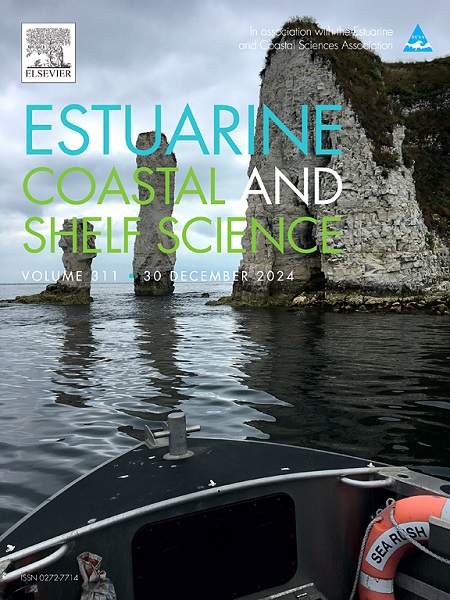Blue carbon stocks in seagrass tissues: A case study from the northern Mexican Caribbean
IF 2.6
3区 地球科学
Q1 MARINE & FRESHWATER BIOLOGY
引用次数: 0
Abstract
Blue Carbon ecosystems, such as seagrass meadows, contribute to climate change mitigation through carbon sequestration and storage. Organic carbon (Corg) stocks in seagrass meadows are mainly concentrated in their sediments. The seagrasses themselves are usually ignored in Corg stock assessments, even though in some systems they may provide a considerable contribution. The Corg stock in the living and dead tissues of Thalassia testudinum and Syringodium filiforme was determined at five mixed meadows in biogenic calcareous sediments the northern Mexican Caribbean. Per site, three core samples (11.2 cm diam) were taken, and the samples were sectioned into four strata: above the sediment, 0–10, 10–20 and 20–30 cm deep, separating dead and living tissues. The highest biomass was observed in the belowground strata to 20 cm depth. The seagrass Corg content varied between 18.2 and 27.4 % (average 22.7 %) of dry weight. T. testudinum and S.filiforme contributed on average 83 % and 17 % to the seagrass Corg stock, respectively. On average, the Corg stocks in seagrass biomass was 6.10 ± 0.77 Corg ha−1 (72 % and 28 % in alive and dead tissues, respectively). The total mean Corg stock (in seagrasses and sediments until 30 cm depth combined) in the five studied meadows was 22.64 ± 3.03SE Mg Corg ha−1. The contribution of the seagrass tissue to the total Corg stock varied among the sites (between 15.2 and 38.0 %) with higher contribution in coarser grained sediments. Thus, in some seagrass systems, the seagrass plants, as well as the sediments, can represent a significant share of the Corg stocks.
海草组织中的蓝碳储量:来自墨西哥加勒比海北部的案例研究
蓝碳生态系统,如海草草甸,通过碳固存和储存有助于减缓气候变化。海草草甸有机碳储量主要集中在其沉积物中。海草本身在长种群评估中通常被忽略,尽管在某些系统中它们可能提供相当大的贡献。测定了墨西哥加勒比海北部5个混合草甸生物钙质沉积物中海棠(Thalassia testudinum)和丝状海雀(Syringodium filforme)活组织和死组织中的Corg储量。每个样点取3个直径11.2 cm的岩心样品,将样品分为4个层:沉积物上方0-10、10-20和20-30 cm,分离死组织和活组织。地下20 cm处生物量最高。海草Corg含量为干重的18.2% ~ 27.4%,平均为22.7%。对海草种群的平均贡献率分别为83%和17%。平均而言,海草生物量的Corg储量为6.10±0.77 Corg ha−1(活组织占72%,死组织占28%)。5个草甸的平均碳储量(海草和沉积物中至30 cm深度的碳储量)为22.64±3.03SE Mg碳ha−1。海草组织对珊瑚总储量的贡献在不同的样点之间(15.2% ~ 38.0%),在粗粒沉积物中贡献较大。因此,在某些海草系统中,海草植物以及沉积物可以代表长种群的很大一部分。
本文章由计算机程序翻译,如有差异,请以英文原文为准。
求助全文
约1分钟内获得全文
求助全文
来源期刊
CiteScore
5.60
自引率
7.10%
发文量
374
审稿时长
9 months
期刊介绍:
Estuarine, Coastal and Shelf Science is an international multidisciplinary journal devoted to the analysis of saline water phenomena ranging from the outer edge of the continental shelf to the upper limits of the tidal zone. The journal provides a unique forum, unifying the multidisciplinary approaches to the study of the oceanography of estuaries, coastal zones, and continental shelf seas. It features original research papers, review papers and short communications treating such disciplines as zoology, botany, geology, sedimentology, physical oceanography.

 求助内容:
求助内容: 应助结果提醒方式:
应助结果提醒方式:


